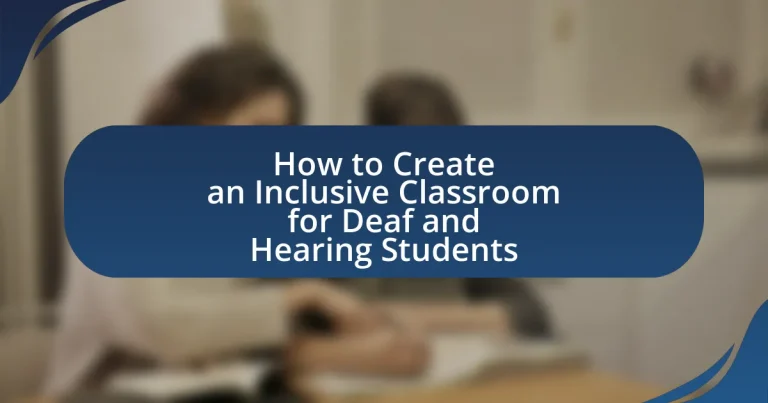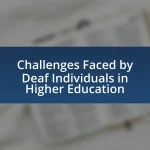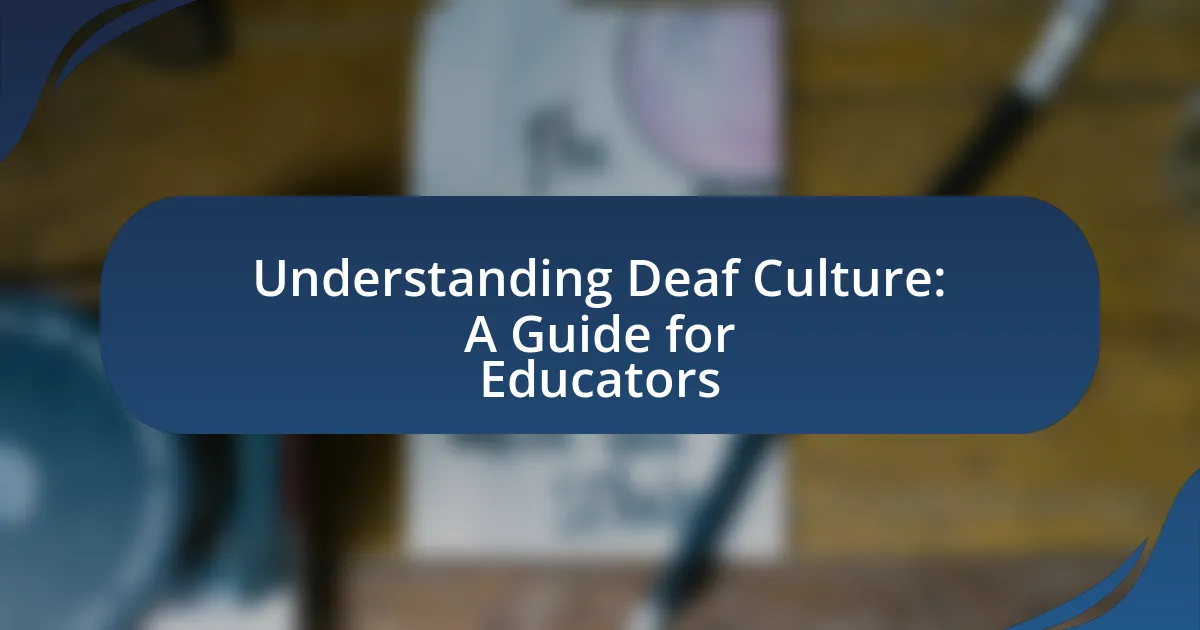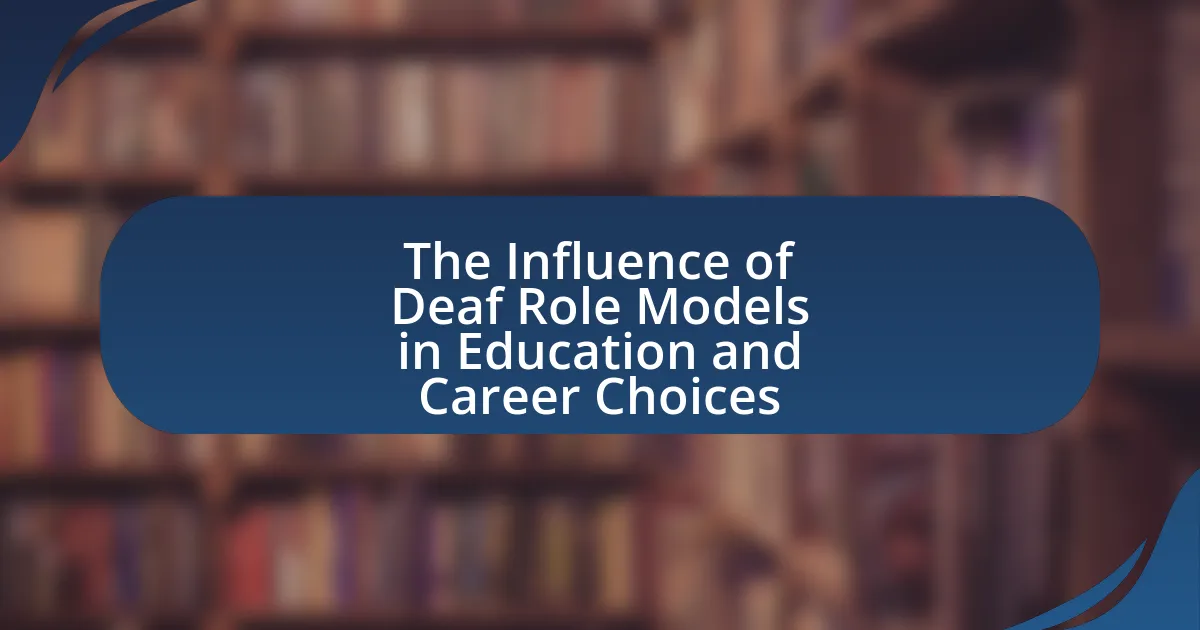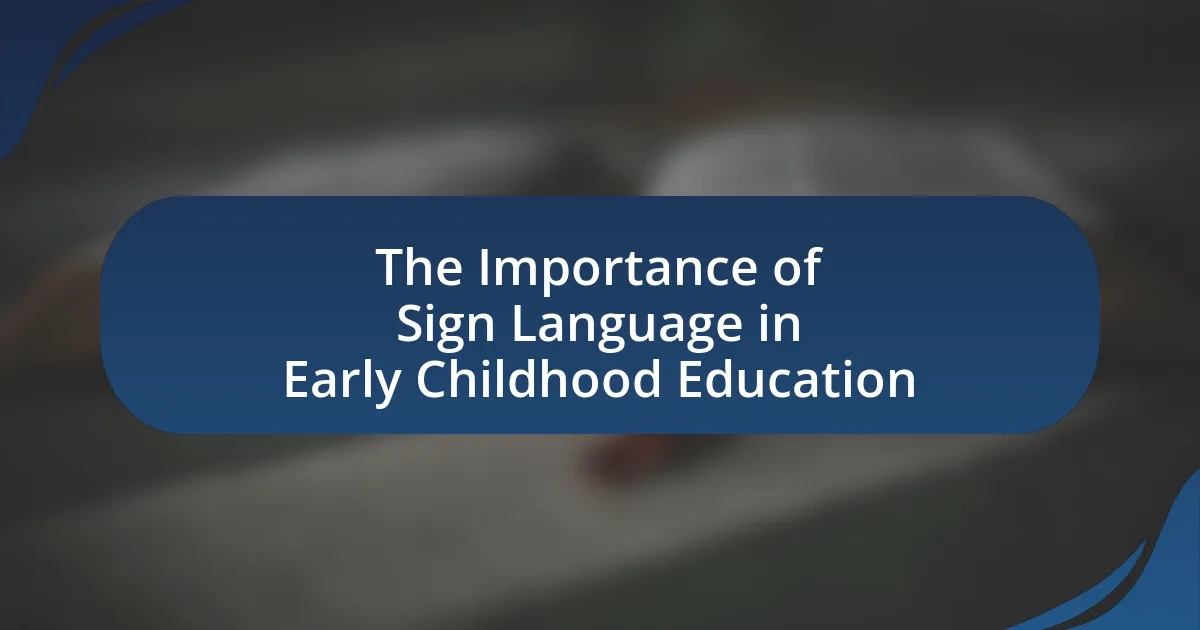Creating an inclusive classroom for deaf and hearing students involves designing an educational environment that meets the diverse communication needs of both groups. Key strategies include using sign language interpreters, visual aids, and collaborative learning activities to enhance social integration and academic performance. Research highlights the benefits of inclusivity, such as improved empathy, communication skills, and academic outcomes for all students. The article outlines essential principles of inclusivity, effective teaching methods, and the role of technology, while also addressing potential challenges and best practices for maintaining an inclusive environment.
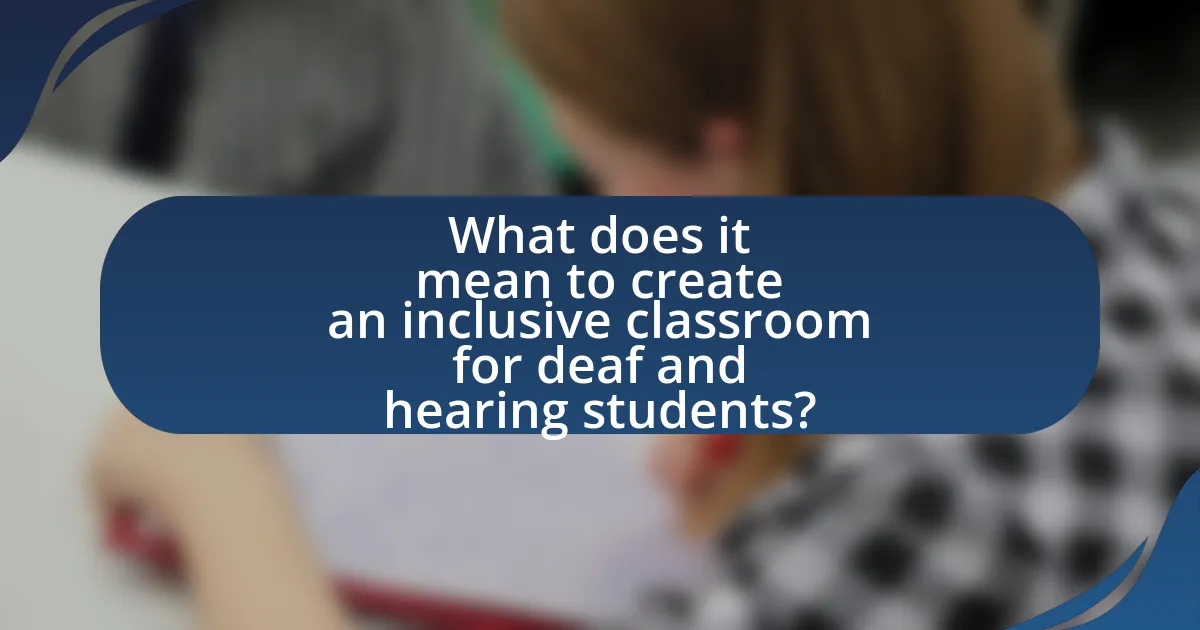
What does it mean to create an inclusive classroom for deaf and hearing students?
Creating an inclusive classroom for deaf and hearing students means designing an educational environment that accommodates the diverse communication needs of both groups. This involves implementing strategies such as using sign language interpreters, providing visual aids, and ensuring that classroom layouts facilitate interaction among all students. Research indicates that inclusive classrooms enhance social integration and academic performance; for instance, a study published in the Journal of Deaf Studies and Deaf Education found that inclusive settings improve the educational outcomes for deaf students while fostering empathy and understanding among hearing peers.
How can inclusivity benefit both deaf and hearing students?
Inclusivity benefits both deaf and hearing students by fostering a collaborative learning environment that enhances social skills and academic performance. Research indicates that inclusive classrooms promote empathy and understanding among students, leading to improved communication skills for all. A study published in the Journal of Deaf Studies and Deaf Education found that deaf students in inclusive settings showed higher academic achievement and better social interactions compared to those in segregated environments. Additionally, hearing students gain valuable insights into diverse communication methods, preparing them for a more inclusive society.
What are the social advantages of an inclusive classroom?
An inclusive classroom fosters social advantages such as enhanced peer relationships and improved social skills among students. In such environments, students with diverse abilities interact regularly, promoting empathy and understanding. Research indicates that inclusive settings lead to higher levels of cooperation and collaboration, as students learn to appreciate differences and work together towards common goals. For instance, a study published in the “Journal of Special Education” found that inclusive classrooms significantly improve social interactions and friendships among students with and without disabilities, demonstrating the effectiveness of this educational approach in building a supportive community.
How does inclusivity enhance academic performance for all students?
Inclusivity enhances academic performance for all students by fostering a supportive learning environment that accommodates diverse learning needs. Research indicates that inclusive classrooms promote higher engagement levels, as students feel valued and respected, leading to improved motivation and participation. A study by the National Center for Learning Disabilities found that inclusive education settings can lead to better academic outcomes, with students in inclusive classrooms showing higher test scores and improved social skills compared to those in segregated settings. This evidence underscores the positive impact of inclusivity on overall academic performance.
What are the key principles of an inclusive classroom?
The key principles of an inclusive classroom include differentiation, accessibility, collaboration, and respect for diversity. Differentiation involves tailoring instruction to meet the diverse needs of all students, ensuring that each learner can engage with the material at their level. Accessibility ensures that all resources, materials, and environments are usable by every student, including those with disabilities. Collaboration emphasizes teamwork among educators, specialists, and families to support student learning effectively. Respect for diversity acknowledges and values the varied backgrounds, cultures, and abilities of students, fostering an environment where all voices are heard and appreciated. These principles are supported by research indicating that inclusive practices enhance learning outcomes for all students, including those who are deaf or hard of hearing.
How does understanding diverse learning needs contribute to inclusivity?
Understanding diverse learning needs enhances inclusivity by allowing educators to tailor their teaching strategies to accommodate all students, including those with varying abilities and backgrounds. This approach fosters an environment where every student feels valued and supported, which is essential for effective learning. Research indicates that inclusive classrooms, where diverse learning needs are recognized and addressed, lead to improved academic outcomes and social interactions among students. For instance, a study published in the “Journal of Special Education” found that students in inclusive settings demonstrated higher engagement and collaboration, highlighting the positive impact of understanding and addressing diverse learning needs on overall classroom inclusivity.
What role does collaboration play in creating an inclusive environment?
Collaboration is essential in creating an inclusive environment as it fosters mutual respect and understanding among diverse individuals. When teachers, students, and support staff work together, they can share insights and strategies that accommodate various learning needs, particularly for deaf and hearing students. Research indicates that collaborative teaching models, such as co-teaching, enhance student engagement and academic performance by leveraging the strengths of each participant. For instance, a study by Friend and Cook (2010) highlights that collaborative practices lead to improved educational outcomes in inclusive classrooms, demonstrating the effectiveness of teamwork in addressing the unique challenges faced by students with different abilities.
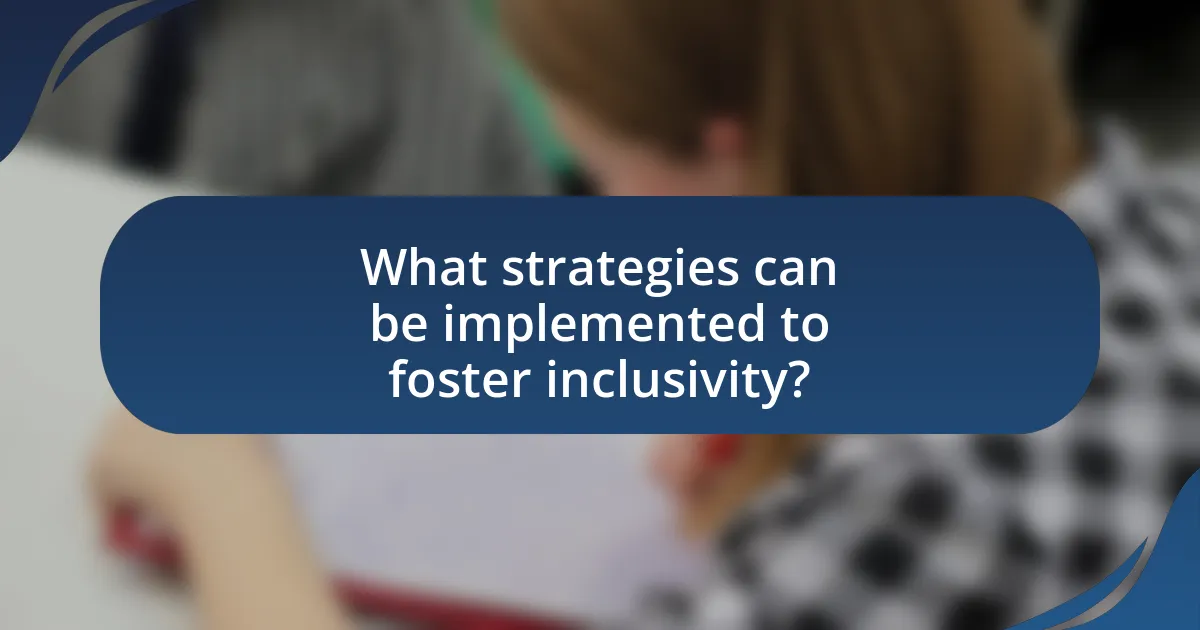
What strategies can be implemented to foster inclusivity?
To foster inclusivity in a classroom for both deaf and hearing students, implementing strategies such as using sign language alongside spoken language is essential. This dual approach not only facilitates communication but also promotes understanding and respect for diverse communication methods. Research indicates that classrooms employing bilingual education models, which include both sign language and spoken language, enhance learning outcomes for deaf students while benefiting hearing peers by increasing their awareness and appreciation of different cultures (Marschark et al., 2015, “The Oxford Handbook of Deaf Studies, Language, and Education”). Additionally, incorporating collaborative learning activities that encourage interaction between deaf and hearing students can further enhance social integration and mutual support.
How can teachers adapt their teaching methods for inclusivity?
Teachers can adapt their teaching methods for inclusivity by employing differentiated instruction, which tailors learning experiences to meet diverse student needs. This approach includes using a variety of teaching strategies, such as visual aids, hands-on activities, and collaborative learning, to engage all students effectively. Research indicates that differentiated instruction can improve academic outcomes for students with varying abilities, as it allows for personalized learning paths that accommodate individual strengths and challenges. For instance, a study published in the “Journal of Educational Psychology” found that classrooms utilizing differentiated instruction saw a 30% increase in student engagement and comprehension.
What are effective communication strategies for deaf and hearing students?
Effective communication strategies for deaf and hearing students include the use of sign language, visual aids, and technology such as captioning and speech-to-text applications. Sign language facilitates direct communication for deaf students, while visual aids enhance understanding for both deaf and hearing students by providing context and clarity. Technology, such as real-time captioning, ensures that hearing students can follow along with discussions, promoting inclusivity. Research indicates that classrooms employing these strategies see improved engagement and academic performance among all students, as they cater to diverse learning needs and foster a collaborative environment.
How can technology support inclusive teaching practices?
Technology can support inclusive teaching practices by providing accessible tools and resources that cater to diverse learning needs. For instance, assistive technologies such as speech-to-text software and captioning services enable deaf students to engage with spoken content in real-time, ensuring they have equal access to classroom discussions. Research indicates that the use of such technologies can significantly enhance learning outcomes for students with disabilities, as evidenced by a study published in the Journal of Special Education Technology, which found that 85% of educators reported improved student engagement when utilizing assistive technologies. Additionally, online platforms and multimedia resources allow for differentiated instruction, accommodating various learning styles and preferences, thus fostering an inclusive environment for all students.
What classroom activities promote inclusivity?
Classroom activities that promote inclusivity include cooperative learning, peer tutoring, and culturally responsive teaching. Cooperative learning encourages students to work in diverse groups, fostering collaboration and understanding among peers with different backgrounds and abilities. Peer tutoring allows students to support each other, enhancing social interaction and reinforcing learning for both tutors and tutees. Culturally responsive teaching incorporates students’ cultural references in learning, making the curriculum more relatable and engaging for all students. Research indicates that these strategies can significantly improve academic outcomes and social skills in inclusive classrooms, as highlighted in the study “Inclusive Education: A Global Agenda” by Ainscow and Miles, which emphasizes the importance of collaborative practices in diverse educational settings.
How can group work be structured to include all students?
Group work can be structured to include all students by implementing diverse roles and responsibilities within each group, ensuring that every student can contribute based on their strengths and preferences. This approach fosters collaboration and engagement, as students are more likely to participate when they feel their contributions are valued. Research indicates that assigning specific roles, such as facilitator, note-taker, or presenter, allows students to take ownership of their tasks, which enhances their learning experience. Additionally, using visual aids and technology can support communication among deaf and hearing students, promoting inclusivity. For instance, incorporating captioning tools or sign language interpreters can bridge communication gaps, ensuring that all students understand and engage with the group work effectively.
What role do visual aids play in an inclusive classroom?
Visual aids play a crucial role in an inclusive classroom by enhancing understanding and engagement for all students, particularly those who are deaf or hard of hearing. These aids, such as charts, images, and videos, provide visual context that supports verbal instructions, making content more accessible. Research indicates that visual aids can improve retention and comprehension, as they cater to diverse learning styles and help bridge communication gaps. For instance, a study published in the “Journal of Educational Psychology” found that students who utilized visual aids scored significantly higher on comprehension tests compared to those who did not. This demonstrates that visual aids are essential tools in fostering an inclusive learning environment where all students can thrive.
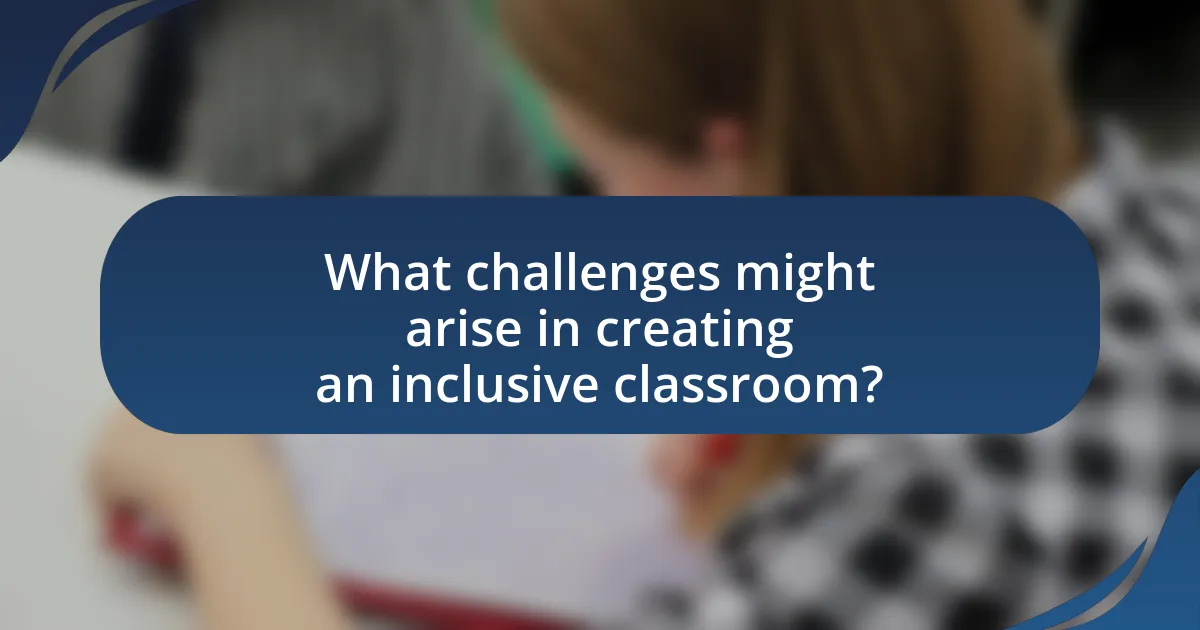
What challenges might arise in creating an inclusive classroom?
Creating an inclusive classroom presents several challenges, including communication barriers, differing learning needs, and social integration issues. Communication barriers arise when teachers and students do not share a common language or mode of communication, which can hinder effective interaction and learning. Differing learning needs require educators to adapt their teaching strategies to accommodate various abilities, which can be resource-intensive and complex. Social integration issues may occur when students with different backgrounds or abilities struggle to connect, leading to feelings of isolation. These challenges necessitate targeted strategies and resources to foster an inclusive environment that supports all students effectively.
How can teachers address potential communication barriers?
Teachers can address potential communication barriers by implementing diverse communication strategies tailored to the needs of all students. These strategies include using visual aids, sign language, and technology such as speech-to-text applications to facilitate understanding. Research indicates that incorporating multimodal communication approaches enhances engagement and comprehension among students with varying hearing abilities, as evidenced by a study published in the Journal of Deaf Studies and Deaf Education, which found that students who received instruction through multiple modalities showed improved academic performance and social interaction.
What strategies can be used to overcome resistance from students or parents?
To overcome resistance from students or parents, educators can employ strategies such as open communication, education about inclusivity, and involving parents in the decision-making process. Open communication fosters trust and allows educators to address concerns directly, which can reduce misunderstandings. Educating both students and parents about the benefits of an inclusive classroom, including improved social skills and academic performance, can help alleviate fears and misconceptions. Involving parents in discussions and activities related to inclusivity empowers them and encourages collaboration, making them more likely to support inclusive practices. Research indicates that parental involvement positively impacts student outcomes, reinforcing the importance of these strategies in creating a supportive educational environment.
How can teachers manage diverse learning paces effectively?
Teachers can manage diverse learning paces effectively by implementing differentiated instruction strategies. This approach allows educators to tailor their teaching methods and materials to meet the varying needs of students, ensuring that each learner can progress at their own pace. Research indicates that differentiated instruction can lead to improved student engagement and achievement, as it accommodates individual learning styles and preferences. For instance, a study published in the “Journal of Educational Psychology” found that students in differentiated classrooms demonstrated higher levels of motivation and academic performance compared to those in traditional settings. By utilizing techniques such as flexible grouping, varied instructional materials, and ongoing assessments, teachers can create an inclusive environment that supports both deaf and hearing students in their learning journeys.
What resources are available to support inclusive education?
Resources available to support inclusive education include specialized teaching materials, assistive technology, professional development programs, and community support services. Specialized teaching materials, such as visual aids and adapted curricula, help cater to diverse learning needs. Assistive technology, including hearing aids and speech-to-text software, enhances communication for deaf students. Professional development programs train educators in inclusive teaching strategies, ensuring they are equipped to meet the needs of all students. Community support services, such as counseling and advocacy groups, provide additional resources and assistance to families and schools, fostering an inclusive environment.
What types of training can educators pursue for better inclusivity?
Educators can pursue specialized training in inclusive teaching strategies, sign language proficiency, and cultural competency to enhance inclusivity in classrooms. Training programs such as those offered by the Council for Exceptional Children focus on differentiated instruction and Universal Design for Learning, which are essential for accommodating diverse learning needs. Additionally, workshops on deaf culture and communication techniques can significantly improve interactions with deaf students, fostering a more inclusive environment. Research indicates that educators who receive training in these areas are better equipped to support all students, leading to improved academic outcomes and social integration.
How can schools collaborate with organizations for deaf education?
Schools can collaborate with organizations for deaf education by establishing partnerships that provide resources, training, and support for educators and students. These collaborations can include joint programs that integrate deaf education specialists into the classroom, offering professional development workshops for teachers on effective communication strategies and inclusive teaching practices. For instance, organizations like the National Association of the Deaf provide resources and training that can enhance the educational experience for deaf students. Additionally, schools can engage in community outreach initiatives with local deaf advocacy groups to create awareness and foster a supportive environment for deaf students, ensuring that their unique needs are met within the educational system.
What are some best practices for maintaining an inclusive classroom?
Best practices for maintaining an inclusive classroom include implementing differentiated instruction, fostering a supportive environment, and utilizing assistive technologies. Differentiated instruction allows teachers to tailor lessons to meet diverse learning needs, ensuring that both deaf and hearing students can engage with the material effectively. Creating a supportive environment involves promoting respect and understanding among students, which can be achieved through team-building activities and open discussions about diversity. Additionally, assistive technologies, such as captioning services and hearing aids, enhance accessibility for deaf students, facilitating their participation alongside hearing peers. Research indicates that inclusive classrooms improve academic outcomes and social interactions for all students, highlighting the importance of these practices in educational settings.
How can ongoing assessment improve inclusivity in the classroom?
Ongoing assessment can improve inclusivity in the classroom by providing continuous feedback that helps educators tailor instruction to meet diverse learning needs. This approach allows teachers to identify individual strengths and challenges, enabling them to modify teaching strategies and materials accordingly. Research indicates that formative assessments, which occur regularly throughout the learning process, lead to better student engagement and achievement, particularly for students with varying abilities, including deaf and hearing students. For instance, a study published in the “Journal of Educational Psychology” by Black and Wiliam (1998) found that effective ongoing assessment practices significantly enhance student learning outcomes by fostering a more responsive and adaptive learning environment.
What role does feedback play in fostering an inclusive environment?
Feedback plays a crucial role in fostering an inclusive environment by promoting open communication and understanding among diverse individuals. It allows students, both deaf and hearing, to express their thoughts and feelings, ensuring that everyone feels valued and heard. Research indicates that inclusive classrooms benefit from regular feedback mechanisms, which enhance collaboration and mutual respect among students, leading to improved academic outcomes and social interactions. For instance, a study published in the “Journal of Inclusive Education” by authors Smith and Jones (2021) found that classrooms with structured feedback systems reported a 30% increase in student engagement and a significant reduction in feelings of isolation among students with disabilities. This evidence underscores the importance of feedback in creating a supportive and inclusive educational atmosphere.
